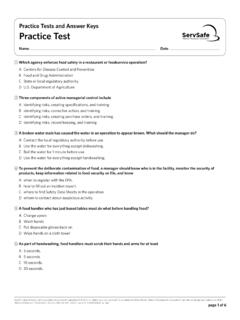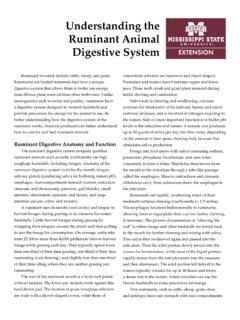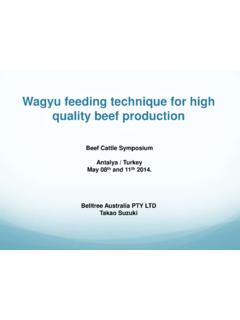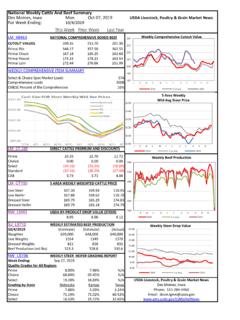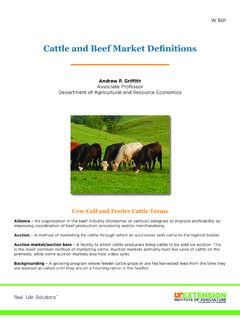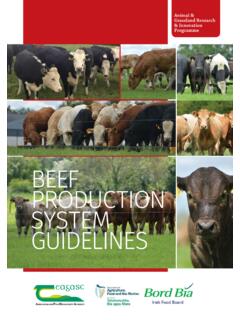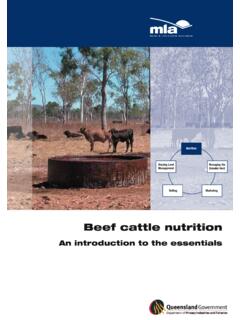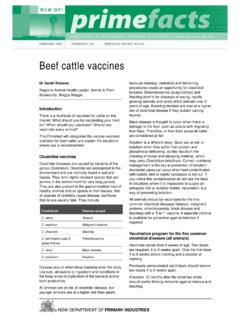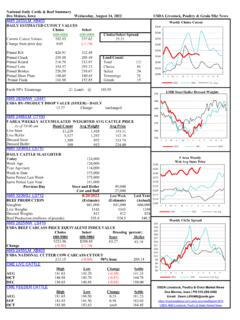Transcription of Protein Requirements of Beef Cattle
1 Cattle Business in Mississippi April 2009 beef production Strategies article Protein Requirements of beef Cattle Jane Parish, MSU Extension beef Cattle Specialist Protein is a critical nutrient in all beef Cattle diets. Signs of Protein deficiency include lowered appetite, weight loss, poor growth, depressed reproductive performance, and reduced milk production . Young, growing Cattle and lactating cows are classes of Cattle most likely to require Protein supplementation. Providing adequate Protein in beef Cattle diets is important for animal health and productivity as well as ranch profitability. Protein Defined Protein in beef Cattle diets is commonly expressed as crude Protein (Figure 1).
2 To determine the crude Protein content of a forage or feedstuff, first measure the nitrogen content of the feed. Then multiply the nitrogen value by , because proteins typically contain 16 percent nitrogen (1 / .16 = ). Crude Protein is comprised of both true Protein and non- Protein nitrogen. Not all nitrogen-containing compounds are true proteins. Urea is an example of a non- Protein nitrogen (NPN) source. Many NPN compounds can supply nitrogen to the rumen microbes that then build microbial Protein in the rumen using this nitrogen. True Protein is sometimes called natural Protein . It is either degradable (can be broken down) or undegradable (cannot be broken down) in the rumen.
3 Ruminally degradable Protein (RDP) is broken down in the rumen and is also referred to as degradable intake Protein (DIP). Ruminally undegradable Protein (RUP) is Protein that is not broken down in the rumen but is potentially degradable in the small intestine. It is sometimes called undegradable intake Protein (UIP) or rumen bypass Protein . A minimum amount of DIP is needed in the diet to support microbial growth. Otherwise the intake and digestibility of the diet will be limited. Crude Protein is the sum of UIP and DIP Metabolizable Protein accounts for rumen degradation of Protein . It separates Protein Requirements into the needs of rumen microorganisms and the needs of the animal.
4 Metabolizable Protein is true Protein absorbed by the intestine. It is made up of microbial Protein and UIP. Figure 1. Protein composition of forage and feed Undegradable Intake ProteinCrude Protein Non Protein Nitrogen True Protein Degradable Intake ProteinDegradableUndegradable beef Cattle Protein Requirements Cattle Protein Requirements vary with stage of production , size of the animal, and expected performance (Figure 2). During lactation, larger Cattle typically require more pounds of crude Protein per day than smaller Cattle but as a lesser percentage of their total dry matter intake. In other words, lighter Cattle require higher quality feeds and forages at lesser quantities compared with heavier Cattle .
5 Cattle Requirements for crude Protein increase with increasing lactation and rate of gain. Protein is required for milk production and reproductive tract reconditioning after calving. Figure 2. beef cow crude Protein (CP) Requirements by stage of production1 120-pound expected peak milk production Young, growing Cattle , in particular, need relatively high levels of crude Protein in their diets to support muscle growth (Figure 3). Creep feeds or forages for nursing calves should contain at least 15 percent crude Protein . High- Protein creep feeds are best used when forage availability is abundant. Average daily gains in nursing calves tend to increase with increasing crude Protein content of creep diets, but expense of the diet will likely also increase with increasing Protein levels.
6 Figure 3. Stocker calf crude Protein (CP) Requirements by rate of gain1 11200-pound expected mature weight Additional Protein and energy are often required to properly balance diets for growing Cattle and lactating beef cows on forage-based diets. This is especially true when low quality stored forages are the majority of the diet as is often the case during the winter hay-feeding period after a poor hay production season or with hay produced under low levels of management. Even average quality hay generally does not meet beef cow Requirements for Protein in the months immediately after calving and during peak lactation. Average quality hay also does not come close to meeting the Protein needs of growing stockers when industry acceptable average daily gains are desired.
7 After identifying the Protein Requirements of specific groups of Cattle , the next step is to identify potential sources of Protein to include in Cattle diets. Next month the beef production Strategies article focuses on Protein supplies for beef Cattle diets. For more information on beef Cattle nutrition or related topics contact a local office of the Mississippi State University Extension Service.






